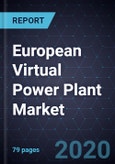Technological Advancements, Fluctuating Energy Demand and Accelerating Growth in Renewables and Prosumers will Drive the Nascent European VPP Market
The global energy market is currently undergoing a massive shift with decarbonization, decentralization and new technologies being the key driving factors. Utilities, independent power producers (IPPs) and other energy companies are exploring effective ways to manage the imbalance created in demand and supply due to the intermittent nature of the growing renewable energy sources (RES) in power generation.
Virtual power plants (VPP) are an aggregation of decentralized distributed energy resources (DERs), energy storage systems (ESS) and controllable loads, all of which are connected and controlled via a central system (VPP software). The aggregated assets form a single imaginary power plant that can be dispatched during times of peak demand eliminating the need for investment into ancillary power generation plants for peak load management. VPP promises significant improvements in grid reliability and resilience and aids in the integration of RES into the grid. In combination with other technologies like Big Data, Internet of Things (IoT) and artificial intelligence (AI), VPP has the potential to deliver the active management of electricity grids through balancing the demand and supply in the energy market.
The European VPP market is still at its early stages and is seen as a solution to solve issues like transmission congestion, peak demand, and peak-hour energy prices. In recent years, VPPs are increasingly being adopted by utilities, VPP aggregators, and ICT companies because of the promise of significant improvements in grid reliability and resiliency, particularly in limiting the need for new peak-period generating capacity. The analyst expects investments in VPP solutions to increase in line with the expansion of DERs in developed economies. Companies must respond with innovative and feasible VPP solutions to address these new energy challenges.
This study includes the following:
- Detailed introduction of VPP and its key components
- Key market drivers and restraints influencing the European VPP market
- Analysis of different business models (supply-side, demand-side, and mixed-asset models) for VPP across Europe
- Discussion on key players in the European VPP market such as Next Kraftwerke, Siemens, ABB, REStore and EDF
- Growth opportunities for companies, along with strategic imperatives for success and growth
The study period is from 2019 to 2030, with 2019 as the base year. The forecast period is from 2020 to 2030. Revenue estimates represent only the revenue generated by selling hardware and software components of VPP solutions provided by both aggregators and independent solution providers, or third-party vendors through partnerships with utilities, and do not include revenue generated through additional services like energy trading.
Market information for the base year has been obtained from both primary and secondary research data and analyses. Key trends and information on market size, tiers of competition, and other variables are based on discussions with key industry stakeholders in the value chain.
Table of Contents
Companies Mentioned (Partial List)
A selection of companies mentioned in this report includes, but is not limited to:
- ABB
- EDF
- Energy 2 Market (e2m)
- Next Kraftwerke
- REStore
- Siemens








